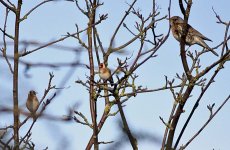Hirundapus
Well-known member
Please excuse me starting a new thread on this if this is the wrong thing to do, but I thought this important regarding the 50D and that it deserved a thread of its own....
On a recent thread, mjobling said:
"Out of the box settings [on the 50D] have a major flaw. A feature called "Auto Lighting Optimizer" is enabled by default, which leads RAW images to look noisy even at 100 ISO, when viewed in DPP. Once this is disabled and the images which had it enabled have the effect removed in DPP, the there is no noise at low ISO and noise handling via DPP at higher ISOs is superb.
I'm wondering if this Auto Lighting Optimizer setting combined with poor RAW handling algorithms from Adobe are causing the lukewarm reception for this camera, as many owners may be oblivious to the problem."
As one who has 'upgraded' from a 40D to a 50D and had not noticed this setting, this is most interesting. Could it explain why I have a general impression that my photos are noisier with the 50D than they were with the 40D? But I am not using DPP. I am processing my photos (always RAWS) in Photoshop CS3 and much prefer to keep doing so if I possibly can. Now, if taking RAW, should this setting always be turned off if processing RAWS in Photoshop CS3 rather than DPP? Does Photoshop recognise and include this setting when it opens files? My initial tests suggest yes, perhaps I should turn this setting off, at least regarding noise, but I am not sure. Does the setting have other positive effects on the image? Any advice much appreciated.
On a recent thread, mjobling said:
"Out of the box settings [on the 50D] have a major flaw. A feature called "Auto Lighting Optimizer" is enabled by default, which leads RAW images to look noisy even at 100 ISO, when viewed in DPP. Once this is disabled and the images which had it enabled have the effect removed in DPP, the there is no noise at low ISO and noise handling via DPP at higher ISOs is superb.
I'm wondering if this Auto Lighting Optimizer setting combined with poor RAW handling algorithms from Adobe are causing the lukewarm reception for this camera, as many owners may be oblivious to the problem."
As one who has 'upgraded' from a 40D to a 50D and had not noticed this setting, this is most interesting. Could it explain why I have a general impression that my photos are noisier with the 50D than they were with the 40D? But I am not using DPP. I am processing my photos (always RAWS) in Photoshop CS3 and much prefer to keep doing so if I possibly can. Now, if taking RAW, should this setting always be turned off if processing RAWS in Photoshop CS3 rather than DPP? Does Photoshop recognise and include this setting when it opens files? My initial tests suggest yes, perhaps I should turn this setting off, at least regarding noise, but I am not sure. Does the setting have other positive effects on the image? Any advice much appreciated.





